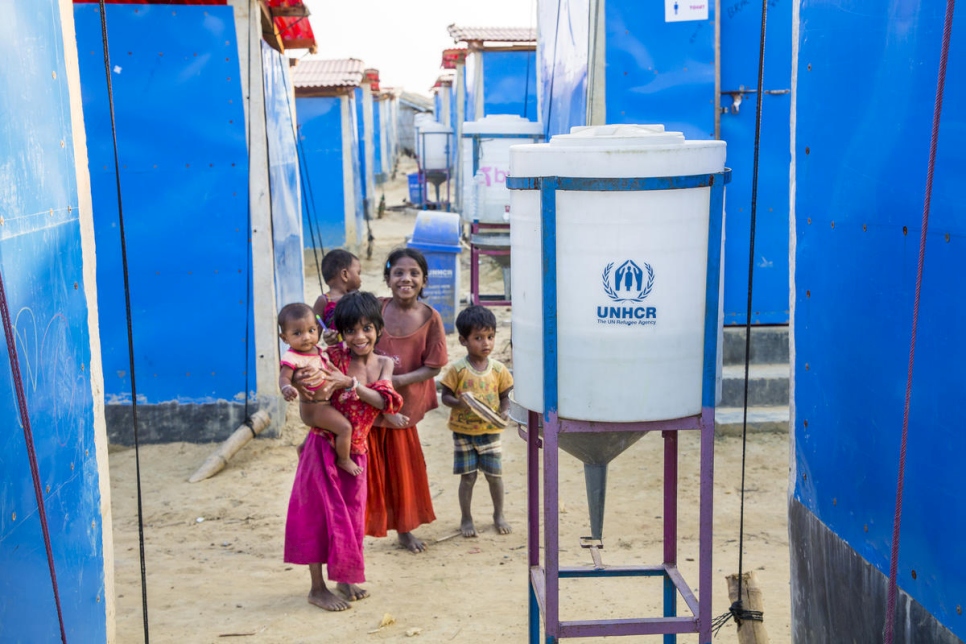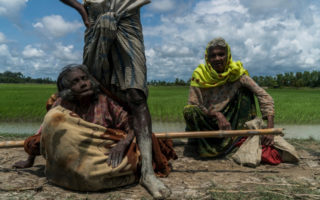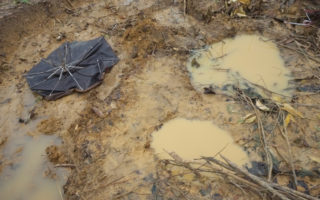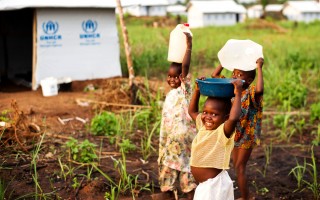
Rohingya children play at Kutupalong refugee settlement in Bangladesh. © UNHCR/Roger Arnold
This is a summary of what was said by UNHCR spokesperson Andrej Mahecic – to whom quoted text may be attributed – at today’s press briefing at the Palais des Nations in Geneva.
The first five solar-powered safe water systems – put in operation by UNHCR, the UN Refugee Agency, in Cox’s Bazar refugee settlements over the past six months – are now delivering at their full capacity. These new systems improve the daily supply of safe, clean drinking water to Rohingya refugees living in crowded sites in southeast Bangladesh.
The project, funded by UNHCR, is part of a broader shift in the humanitarian response towards the expanded use of green and non-polluting technologies.
The new safe water systems run entirely on electricity generated through solar panels. Motorised pumps draw water from newly-installed 70,000 litre chlorinated tanks. The water is then piped to collective taps strategically installed throughout the Kutupalong-Balukhali site. UNHCR’s aim is to provide 20 litres of safe and clean water to every single refugee on a daily basis.
More than 900,000 Rohingya refugees live across 36 different locations in Cox’s Bazar area. Water is scarce in most locations. During the dry season, for example, the only solution in the Nayapara site is to truck water, which is very costly. It has been challenging to secure adequate water sources for the whole refugee population – most of whom fled to Bangladesh in late 2017. This is why UNHCR and partners have stepped up their efforts throughout 2018 to address the massive water and sanitation needs.
Using solar energy has allowed the humanitarian community to reduce energy costs and emissions. Chlorination is a life-saver in refugee sites of this scale. Recent tests revealed that most contamination to drinking water occurs during collection, transport and storage at the household level.
Chlorinated water is safe for drinking and eliminates risks of spread of diseases. Previous water sources, mainly boreholes fitted with hand pumps were often highly contaminated by waste water penetrating the wells.
The five new water networks – jointly completed by UNHCR MSF, OXFAM and BRAC – are providing safe water to over 40,000 refugees at present. A further 55,000 refugees will benefit as UNHCR and its partner agencies are hoping to install nine more solar-powered water networks across Kutapalong refugee camp in the coming year, at a cost of 10 million USD.
The effort to provide enough safe drinking water for refugees across all the heavily congested sites has been a massive challenge, requiring the drilling of thousands of deep tube wells and building water networks, including the installation of pipes, dams, canals, filtering mechanisms and chlorination systems.
Throughout 2018 UNHCR has been stepping up its efforts in water and sanitation by investing in green technologies that save energy and reduce pollution. It has also increased its team in Cox’s Bazar, bringing in more experts and new partners, to build dams in streams to create water reservoirs from which clean, chlorinated potable water will be produced.
UNHCR has been working closely with the Government of Bangladesh to identify water sources. The authorities have also helped with expert advice and permissions to dig tube wells and build other structures such as water reservoirs, water treatment plants, pipelines, water storage tanks, chlorination systems and boreholes fitted with hand pumps.
For more information on this topic, please contact:
- In Dhaka, Joseph Tripura, tripura@unhcr.org, +88 17 1309 0375
- In Bangkok, Caroline Gluck, gluck@unhcr.org, +66 81 827 0280
- In Geneva, Andrej Mahecic, mahecic@unhcr.org, +41 79 642 97 09
Originally published by UNHCR on 4 January 2018





